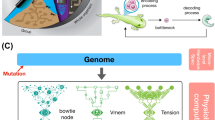Abstract
We present a model of three-dimensional artificial embryogenesis in which a multicellular embryo develops controlled by a continuous regulatory network encoded in a linear genome. Development takes place in a continuous space, with spherical cells of variable size, and is controlled by simulated physics. We apply a genetic algorithm to the problem of the simultaneous evolution of morphology and patterning into colour stripes and demonstrate how the system achieves the task by exploiting physical forces and using self-generated morphogen gradients. We observe a high degree of robustness to damage in evolved individuals and explore the limits of the system using more complex variations of the problem. We find that the system remains highly evolvable despite the increased complexity of three-dimensional space and the flexible coding of the genome requiring from evolution to invent all necessary morphogens and transcription factors.
Access this chapter
Tax calculation will be finalised at checkout
Purchases are for personal use only
Preview
Unable to display preview. Download preview PDF.
Similar content being viewed by others
References
Bentley, P., Kumar, S.: Three ways to grow designs: A comparison of embryogenies for an evolutionary design problem. In: Proceedings of the Genetic and Evolutionary Computation Conference, Orlando, Florida, USA, vol. 1, pp. 35–43. Morgan Kaufmann, San Francisco (1999)
Stanley, K., Miikkulainen, R.: A taxonomy for artificial embryogeny. Artificial Life 9(2), 93–130 (2003)
Wolpert, L.: Positional information and the spatial pattern of cellular differentiation. J. Theor. Biol. 25(1), 1–47 (1969)
Miller, J.F.: Evolving a self-repairing, self-regulating, french flag organism. In: Deb, K., et al. (eds.) GECCO 2004. LNCS, vol. 3102, pp. 129–139. Springer, Heidelberg (2004)
Beurier, G., Michel, F., Ferber, J.: A morphogenesis model for multiagent embryogeny. In: Proceedings of ALIFE X, pp. 84–90. MIT Press, Cambridge (2006)
Chavoya, A., Duthen, Y.: A cell pattern generation model based on an extended artificial regulatory network. Biosystems 94(1-2), 95–101 (2008)
Hogeweg, P.: Evolving mechanisms of morphogenesis: on the interplay between differential adhesion and cell differentiation. J. Theor. Biol. 203(4), 317–333 (2000)
Knabe, J.F., Nehaniv, C.L., Schilstra, M.J.: Evolution and morphogenesis of differentiated multicellular organisms: autonomously generated diffusion gradients for positional information. In: Proceedings of ALIFE XI, pp. 321–328. MIT Press, Cambridge (2008)
Hotz, P.E.: Genome-physics interaction as a new concept to reduce the number of genetic parameters in artificial evolution. In: Congress on Evolutionary Computation, CEC 2003., vol. 1, pp. 191–198 (2003)
Doursat, R.: Programmable architectures that are complex and self-organized: From morphogenesis to engineering. In: Proceedings of Artificial XI, pp. 181–188. MIT Press, Cambridge (2008)
Kumar, S.: Investigating Computational Models of Development for the Construction of Shape and Form. PhD thesis, Dept. of Computer Science, University College London (2004)
Joachimczak, M., Wróbel, B.: Evo-devo in silico: a model of a gene network regulating multicellular development in 3D space with artificial physics. In: Proceedings of Artificial XI, pp. 297–304. MIT Press, Cambridge (2008)
Haddow, P.C., Hoye, J.: Achieving a simple development model for 3D shapes: are chemicals necessary? In: Proceedings of the 9th Annual Conference on Genetic and Evolutionary Computation (GECCO 2007), pp. 1013–1020. ACM, New York (2007)
Prusinkiewicz, P., Lindenmayer, A.: The algorithmic beauty of plants. Springer, New York (1996)
Carroll, S.B., Grenier, J.K., Weatherbee, S.D.: From DNA to Diversity: Molecular Genetics and the Evolution of Animal Design. Blackwell Publishers, Malden (2004)
Eggenberger, P.: Exploring regenerative mechanisms found in flatworms by artificial evolutionary techniques using genetic regulatory networks. In: The Congress on Evolutionary Computation, CEC 2003, vol. 3, pp. 2026–2033 (2003)
Federici, D., Ziemke, T.: Why are evolved developing organisms also fault-tolerant? In: Nolfi, S., Baldassarre, G., Calabretta, R., Hallam, J.C.T., Marocco, D., Meyer, J.-A., Miglino, O., Parisi, D. (eds.) SAB 2006. LNCS (LNAI), vol. 4095, pp. 449–460. Springer, Heidelberg (2006)
Author information
Authors and Affiliations
Editor information
Editors and Affiliations
Rights and permissions
Copyright information
© 2011 Springer-Verlag Berlin Heidelberg
About this paper
Cite this paper
Joachimczak, M., Wróbel, B. (2011). Evolution of the Morphology and Patterning of Artificial Embryos: Scaling the Tricolour Problem to the Third Dimension. In: Kampis, G., Karsai, I., Szathmáry, E. (eds) Advances in Artificial Life. Darwin Meets von Neumann. ECAL 2009. Lecture Notes in Computer Science(), vol 5777. Springer, Berlin, Heidelberg. https://doi.org/10.1007/978-3-642-21283-3_5
Download citation
DOI: https://doi.org/10.1007/978-3-642-21283-3_5
Publisher Name: Springer, Berlin, Heidelberg
Print ISBN: 978-3-642-21282-6
Online ISBN: 978-3-642-21283-3
eBook Packages: Computer ScienceComputer Science (R0)




